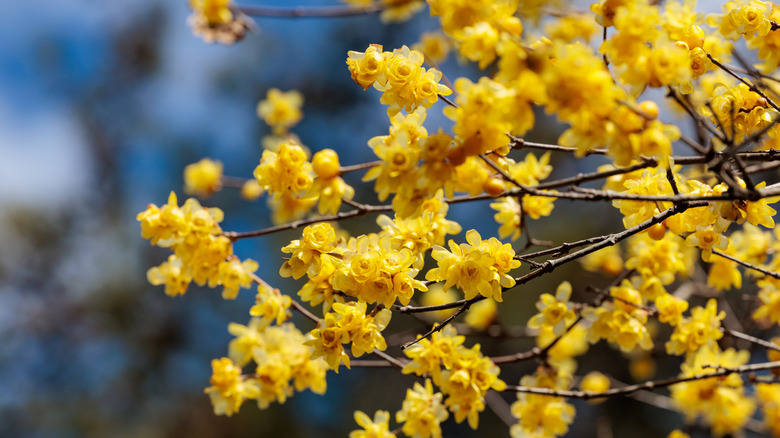Add Beauty To Sunny Spots In Your Yard With A Flowering Tree That Birds Love
Do you have a sunny spot in your yard that you'd dearly like to fill with a beautiful tree that doesn't get too large and won't overwhelm your entire garden? Of course, a small tree that also has fragrant flowers in winter and into spring — and attracts pollinators and birds — would be a bonus. One outstanding specimen that fills all these criteria is the wintersweet tree (Chimonanthus praecox). It's one of several flowering dwarf trees that bring color to your yard, and it will certainly brighten up those dull winter days.
Technically, wintersweet is labeled as a shrub, but because it can reach a maximum height of 13 feet with a spread of 12 feet, it can easily be regarded as a tree, even though it's normally multi-trunked, with lovely arching branches. The most spectacular feature of wintersweet is its gorgeous, waxy, almost translucent flowers, which are normally pale yellow. These appear in winter on bare branches, as the plant is deciduous, and persist into spring. They're delightfully fragrant with a scent like honey, and you'll find the tree buzzing with bees as the weather starts to warm up.
These blooms morph into urn-shaped fruits which will feed all the birds that like to visit your garden in spring. Even the lance-shaped green leaves are quite attractive in summer, with their highly visible veins.
How to grow a wintersweet tree in your sunny yard
If you live anywhere in USDA hardiness zones 7 through 9, you can grow this delightful specimen in your yard. Although it can handle some dappled shade, this is one small tree that loves full sun. Wintersweet will adapt to most soil types, but it should be relatively moist and well-drained.
As wintersweet can turn a little rangy or unruly in its growth after a few years, you might be tempted to prune it back quite severely after it finishes flowering. While you can certainly do this, be aware that the tree blooms on old wood from the previous year, so this heavy rejuvenation could result in fewer flowers or more sporadic flowering the following year. In most cases, it's best to prune wintersweet only lightly to remove any dead or damaged branches, until such time that you feel it needs a complete overhaul.
Not only will the birds and bees thank you for planting wintersweet in your yard, but those sweet flowers might lure you out into the garden in winter to enjoy their magnificent fragrance. Once you have this tree planted in your yard, you might well be tempted to find a few other beautiful plants to grow for a fragrant garden in winter, such as winter hazel (Corylopsis spp.) and sweet box (Sarcococca spp.).

